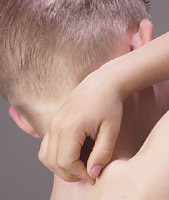Itching for a better anti-itch remedy? Your wish may soon be granted now that scientists at Washington University School of Medicine in St. Louis have identified the first gene for the itch sensation in the central nervous system. The discovery could rapidly lead to new treatments directly targeting itchiness and providing relief for chronic and severe itching.

Historically, scientists regarded itch as just a less intense version of the pain sensation. As a result, research on itching has been somewhat neglected. “Many genes have been identified in the pain pathway,” says Chen, associate professor of anesthesiology, psychiatry and molecular biology and pharmacology. “But itch research has lived in the shadow of pain research, and no one knew which gene was responsible for itching in the brain or in the spinal cord until now.”
In fact, Chen’s team became interested in GRPR because they were looking for genes in the pain pathway. Among potential pain-sensing genes they identified, GRPR stood out because it is present in only a few nerve cells in the spinal cord known to relay pain and/or itch signals to the brain.
So they began to study some mice that were missing the GRPR gene to find out how they were different from normal mice. “The research was a little disappointing at first,” Chen says. “The knockout mice seemed to have the same reactions to painful stimuli as normal mice.”
But when post-doctoral fellow Yan-Gang Sun, Ph.D., injected the spinal cords of normal mice with a substance that stimulates GRPR, the mice started scratching themselves as if they had a bad itch. “That’s when we thought the gene might be involved in the itch sensation,” Chen says. “So we began to systematically investigate this possibility.”
They studied scratching behavior in two sets of mice — normal mice and GRPR knockout mice. Normal mice scratched vigorously when exposed to a variety of itch-producing substances, but the knockout mice scratched much less. “The fact that the knockout mice still scratched a little suggests there are additional itch receptors,” Chen says. “We know of some proteins that are similar to GRPR, so now we’re trying to determine if there is functional redundancy in the itching pathway.”
GRPR knockout mice had normal reactions to painful stimuli, indicating that pain and itch are mediated by separate sets of genes in the spinal cord. This suggests that drugs can be used to suppress the itch sensation without affecting the pain sensation, according to Chen. And because pain can be an important protective cue that warns of danger, it may be a distinct advantage to have an anti-itch medication that doesn’t compromise our pain-sensing capability.
GRPR had been fairly well studied before, but no one could provide a compelling link between GRPR and itching before now. “Scientists have been studying this receptor for more than a decade,” Chen says. “One interesting thing they’ve found is that GRPR is implicated in tumor growth. As a result of research like this, a lot of substances have been made that block the activity of GRPR. So now researchers can study the effect of these agents on the itch sensation and possibly move that research to clinical applications fairly soon.”
Sun YG, Chen ZF. A gastrin-releasing peptide receptor mediates the itch sensation in the spinal cord. Nature July 25, 2007, advance online publication.
Funding from the National Institutes of Health supported this research.
Washington University School of Medicine’s full-time and volunteer faculty physicians also are the medical staff of Barnes-Jewish and St. Louis Children’s hospitals. The School of Medicine is one of the leading medical research, teaching and patient care institutions in the nation, currently ranked fourth in the nation by U.S. News & World Report. Through its affiliations with Barnes-Jewish and St. Louis Children’s hospitals, the School of Medicine is linked to BJC HealthCare.